|
|
|
Sort Order |
|
|
|
Items / Page
|
|
|
|
|
|
|
| Srl | Item |
| 1 |
ID:
127302
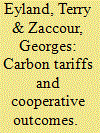

|
|
|
|
|
| Publication |
2014.
|
| Summary/Abstract |
In the absence of an international environmental agreement (IEA) on climate change, a country may be reluctant to unilaterally implement environmental actions, as this may lead to the relocation of firms to other, lax-on-pollution countries. To avoid this problem, while still taking care of the environment, a country may impose a carbon tariff that adjusts for the differences between its own carbon tax and the other country's tax. We consider two countries with a representative firm in each one, and characterize and contrast the equilibrium strategies and outcomes in three scenarios. In the first (benchmark) scenario, in a first stage the regulators in the two countries determine the carbon taxes noncooperatively, and in a second stage, the firms compete à la Cournot. In the second scenario, the regulators cooperate in determining the carbon taxes, while the firms still play a noncooperative Cournot game. In the third scenario, we add another player, e.g., the World Trade Organization, which announced a border tax in a prior stage; the game is then played as in the first scenario. Our two major results are (i) a border-tax adjustment (BTA) mimics quite well the cooperative solution in setting the carbon taxes as in scenario two. This means that a BTA may be a way around the lack of enthusiasm for an IEA. (ii) All of our simulations show that a partial correction of the difference in taxes is sufficient to maximize total welfare. In short, the conclusion is that a BTA may be used as a credible threat to achieve an outcome that is very close to the cooperative outcome.
|
|
|
|
|
|
|
|
|
|
|
|
|
|
|
|
| 2 |
ID:
127299
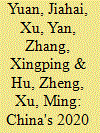

|
|
|
|
|
| Publication |
2014.
|
| Summary/Abstract |
China has proposed its 2020 clean energy target together with the climate change target of reducing CO2 intensity of the economy by 40-45% below the 2005 level. This article investigates the feasibility of these targets by testing their consistency under possible economic development scenarios. We analyse these targets from two perspectives: consistency with the overall economic growth and consistency with the international society's expectation on China's greenhouse gas (GHG) abatement responsibilities. The main findings are: under the recently announced 2020 target of gross domestic product (GDP) that is double the 2010 level, the adoption of a 15% clean energy target could result in excessive primary energy demand; and then with 40-45% GDP CO2 intensity reduction, CO2 emissions in 2020 could substantially exceed the International Energy Agency (IEA) 450 ppm scenario for China. Thus we propose a 17% clean energy target that can reconcile the domestic plan with international expectation. Our article also outlines the pathways to realise clean energy development into 2020 and proposes policy recommendations.
|
|
|
|
|
|
|
|
|
|
|
|
|
|
|
|
| 3 |
ID:
127295
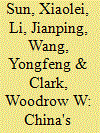

|
|
|
|
|
| Publication |
2014.
|
| Summary/Abstract |
Sovereign Wealth Funds (SWFs) are state-owned investment funds that invest in real and financial assets. Since the global financial crisis in 2008, SWFs' investments have resulted in national security concerns of host countries because SWFs continue to expand rapidly and have become increasingly active in real-time strategic transactions. Given this background, China, which has the biggest SWF in the world, is facing severe challenges of energy resources shortages while its plan is to accomplish social and economic development goals. Energy security is a key driving force of the energy investment policy of China's SWFs. This makes the SWF investments more complicated and more politically sensitive. The combination of sovereign rights and the strategic importance of energy also makes geopolitics more complicated and brings more uncertainty to SWF investments. This article explores the relationship between energy security and energy investments of China's SWFs. It is recognised that the energy investment of SWFs must follow a sustainable path to coordinate energy security, economic growth, return on investment and national security concerns. Government policymakers are urged to balance the financial and political returns on SWFs against potential negative effects. The conclusion presents insights for policymakers, energy scholars and SWF researchers.
|
|
|
|
|
|
|
|
|
|
|
|
|
|
|
|
| 4 |
ID:
127301
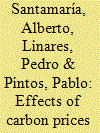

|
|
|
|
|
| Publication |
2014.
|
| Summary/Abstract |
This paper assesses the impacts on the cement, steel and oil refining sectors in Spain of the carbon prices derived from the European Emissions Trading Scheme (EU ETS), and the potential effect on these sectors of the European Union anti-leakage policy measures. The assessment is carried out by means of three engineering models developed for this purpose. Our results show a high exposure to leakage of cement in coastal regions; a smaller risk in the steel sector, and non-negligible risk of leakage for the oil refining sector when carbon allowance prices reach high levels. We also find that the risk of leakage could be better handled with other anti-leakage policies than those currently in place in the EU.
|
|
|
|
|
|
|
|
|
|
|
|
|
|
|
|
| 5 |
ID:
127291
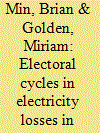

|
|
|
|
|
| Publication |
2014.
|
| Summary/Abstract |
A third of electricity in India is lost each year, where losses refer to power that is supplied but not billed. Utilizing data from the power corporation of Uttar Pradesh, India's most populous state, we study the politics of electricity losses. Examining annual data over four decades, we document that UP's electricity losses tend to increase in periods immediately prior to state assembly elections. Drawing upon geographically disaggregated data for the period 2000-09, we observe higher line losses just prior to the 2002 and 2007 state elections. Our analysis shows that the incumbent party was more likely to retain the assembly seat as line losses in the locality increased. We interpret these results as corroboration that political parties deliberately redirect electricity to flat rate and unbilled users in a context of chronically inadequate supply. Political factors appear to affect line losses in ways that technical and economic factors alone cannot explain.
|
|
|
|
|
|
|
|
|
|
|
|
|
|
|
|
| 6 |
ID:
127305


|
|
|
|
|
| Publication |
2014.
|
| Summary/Abstract |
The emergence of biofuel as a renewable energy source offers opportunities for significant climate change mitigation and greater energy independence to many countries. At the same time, biofuel represents the possibility of substitution between energy and food. For developing countries like India, which imports over 75% of its crude oil, fossil fuels pose two risks-global warming pollution and long-term risk that oil prices will undermine real living standards. This paper examines India's options for managing energy price risk in three ways: biofuel development, energy efficiency promotion, and food productivity improvements. Our salient results suggest that biodiesel shows promise as a transport fuel substitute that can be produced in ways that fully utilize marginal agricultural resources and hence promote rural livelihoods. First-generation bioethanol, by contrast, appears to have a limited ability to offset the impacts of oil price hikes. Combining the biodiesel expansion policy with energy efficiency improvements and food productivity increases proved to be a more effective strategy to enhance both energy and food security, help mitigate climate change, and cushion the economy against oil price shocks.
|
|
|
|
|
|
|
|
|
|
|
|
|
|
|
|
| 7 |
ID:
127304


|
|
|
|
|
| Publication |
2014.
|
| Summary/Abstract |
How would a low-carbon energy transformation affect energy security? This paper proposes a framework to evaluate energy security under long-term energy scenarios generated by integrated assessment models. Energy security is defined as low vulnerability of vital energy systems, delineated along geographic and sectoral boundaries. The proposed framework considers vulnerability as a combination of risks associated with inter-regional energy trade and resilience reflected in energy intensity and diversity of energy sources and technologies. We apply this framework to 43 scenarios generated by the MESSAGE model as part of the Global Energy Assessment, including one baseline scenario and 42 'low-carbon' scenarios where the global mean temperature increase is limited to 2°C over the pre-industrial level. By and large, low-carbon scenarios are associated with lower energy trade and higher diversity of energy options, especially in the transport sector. A few risks do emerge under low-carbon scenarios in the latter half of the century. They include potentially high trade in natural gas and hydrogen and low diversity of electricity sources. Trade is typically lower in scenarios which emphasize demand-side policies as well as non-tradable energy sources (nuclear and renewables) while diversity is higher in scenarios which limit the penetration of intermittent renewables.
|
|
|
|
|
|
|
|
|
|
|
|
|
|
|
|
| 8 |
ID:
127298


|
|
|
|
|
| Publication |
2014.
|
| Summary/Abstract |
Biodiesel production in Brazil has grown from 736 m3 in 2007 to 2.7 Mm3 in 2012. It is an emergent bioenergy for which it is important to guarantee environmental sustainability. The objective of this article is to characterise the biodiesel production chain in Brazil, to identify potential environmental impacts and to analyse key drivers and barriers for biodiesel environmental sustainability. This article explores these aspects and focusses on the increasing demand for the main feedstocks for biodiesel production in Brazil: soybean oil and beef tallow. The impacts of land use and land-use change on greenhouse gas emissions, biodiversity and water, as well as the energy balance, were found to be critical for the environmental sustainability assessment and development of biodiesel chains. Increasing agriculture yields, diversifying feedstocks and adopting ethyl transesterification can contribute to minimise environmental impacts. It was also found that environmental impacts could be mitigated by appropriate policies aiming at an integrated optimisation of food and bioenergy production and through agro-economic-ecological zoning, allowing adequate use of land for each purpose. Despite the limitation and weakness of some sustainability tools and initiatives, certification and zoning can play an important role in the sustainability of the emerging biodiesel production in Brazil.
|
|
|
|
|
|
|
|
|
|
|
|
|
|
|
|
| 9 |
ID:
127297


|
|
|
|
|
| Publication |
2014.
|
| Summary/Abstract |
This article employs the multi-level perspective on socio-technical transitions to explore the historical evolution of the electricity regime in the province of Ontario from 1885-2013 and to interpret the potential for future movement towards decarbonization. With an emphasis on the political and social dimensions of transitions, this analysis traces the key features influencing change within Ontario's electricity system over the past century. This paper uses multiple criteria (the phase of electrification; role of the electricity system in economic development; structures of ownership, market and regulation; dominant technologies; and the relative stability of arrangements) to characterize distinct regime configurations and periods of instability which separate relatively stable system orientations. Lessons are drawn from the historical case with implications for future decarbonization in the province, including the importance of: (1) residual momentum; (2) embedded guiding principles; and, (3) Politico-Economic Coalitions.
|
|
|
|
|
|
|
|
|
|
|
|
|
|
|
|
| 10 |
ID:
127293


|
|
|
|
|
| Publication |
2014.
|
| Summary/Abstract |
This paper describes and analyses the multi-actor governance process that made Mozambique the first African nation-state to develop a national policy framework for sustainable biofuels. The paper draws on findings from action research conducted in Mozambique between December 2008 and July 2012. We analyse interactions between the changing governance context, the course of the multi-actor governance process, and the choices in relation to governance framework characteristics and content for four successive stages of governance framework development. This provides the basis for reflection on the competences required for effective multi-actor sustainability governance, and a discussion about the role of the nation-state in sustainability governance of global economies such as biofuels.
The governance framework for sustainable biofuels has contributed to a more transparent and secure investment climate for biofuels in Mozambique. Key factors for success were (1) the presence of different types of competences during the various stages of the governance framework development, (2) closing the gap between 'licences to sell' and 'licences to produce' across different governance levels, and (3) balancing between the short- and long-term objectives for biofuel production in Mozambique and requirements of global biofuel markets. Developing-country nation-states can provide an essential contribution to these success-factors for global governance of sustainable biofuels.
|
|
|
|
|
|
|
|
|
|
|
|
|
|
|
|
| 11 |
ID:
127294


|
|
|
|
|
| Publication |
2014.
|
| Summary/Abstract |
A nation-wide survey was conducted in 2010 to investigate the Australian public's attitudes to nuclear power in relation to climate change and in comparison to other energy alternatives. The survey showed a majority of respondents (42%) willing to accept nuclear power if it would help tackle climate change. Following the disaster at the Fukushima Daiichi Nuclear Power Complex in Japan, an event triggered by the 11 March 2011 Tohoku earthquake and tsunami, it was expected that support for nuclear power in Australia would change. In light of this, a follow-up survey was conducted in 2012. Indeed, the post-Fukushima results show a majority of respondents (40%) were not willing to accept nuclear power as an option to help tackle climate change, despite the fact that most Australians still believed nuclear power to offer a cleaner, more efficient option than coal, which currently dominates the domestic production of energy. Expanding the use of renewable energy sources (71%) remains the most popular option, followed by energy-efficient technologies (58%) and behavioural change (54%). Opposition to nuclear power will continue to be an obstacle against its future development even when posed as a viable solution to climate change.
|
|
|
|
|
|
|
|
|
|
|
|
|
|
|
|
| 12 |
ID:
127296


|
|
|
|
|
| Publication |
2014.
|
| Summary/Abstract |
Evidence suggests that state control of wind facility siting decisions fosters new project development more effectively than local control, yet the literature suggests that affected citizens tend to be more fairly represented in local siting processes. We argue that successful renewable energy policy must satisfy both the need for new project development and the obligation to procedural justice. To suggest how it can do so, we analyze existing state- and county-level siting processes in Washington state, finding that both fall short on measures of procedural justice. To overcome this limitation and address the tension between procedural justice and project development, we then propose a collaborative governance approach to wind facility siting, in which state governments retain ultimate authority over permitting decisions but encourage and support local-level deliberations as the primary means of making those decisions. Such an approach, we argue, would be more just, facilitate wind development by addressing community concerns constructively and result in better projects through the input of diverse stakeholders
|
|
|
|
|
|
|
|
|
|
|
|
|
|
|
|
| 13 |
ID:
127292


|
|
|
|
|
| Publication |
2014.
|
| Summary/Abstract |
Energy efficiency levels for the Standards and Labeling (S&L) program in India for frost free (FF) refrigerators are compared with similar programs in China, United States of America (USA), and European Union (EU). A normalization method developed by International Energy Agency (IEA) is adopted with India as a benchmark for comparison. It is observed that the energy consumption level corresponding to minimum energy performance standard (MEPS) is very high in India. India also lags behind other countries on the consumption level corresponding to highest efficiency rating. Also, the range of consumption levels corresponding to a label is wide which dilutes the efficacy of label. India has aggressively proposed to tighten the ratings for FF refrigerators in 2014 by 36% across all the bands. This measure will make its highest efficiency rating comparable to other countries. However, due to the wide gap in the consumption levels across the ratings, the revised MEPS will still lag behind other countries. One possible outcome of high MEPS is that as the ratings are tightened, the market may move to lower star rated models significantly undermining the tightening effect.
|
|
|
|
|
|
|
|
|
|
|
|
|
|
|
|
| 14 |
ID:
127303


|
|
|
|
|
| Publication |
2014.
|
| Summary/Abstract |
Financial market participants and policy-makers can benefit from a better understanding of how shocks can affect volatility over time. This study assesses the impact of structural changes and outliers on volatility persistence of three crude oil markets - Brent, West Texas Intermediate (WTI) and Organization of Petroleum Exporting Countries (OPEC) - between January 2, 1985 and June 17, 2011. We identify outliers using a new semi-parametric test based on conditional heteroscedasticity models. These large shocks can be associated with particular event patterns, such as the invasion of Kuwait by Iraq, the Operation Desert Storm, the Operation Desert Fox, and the Global Financial Crisis as well as OPEC announcements on production reduction or US announcements on crude inventories. We show that outliers can bias (i) the estimates of the parameters of the equation governing volatility dynamics; (ii) the regularity and non-negativity conditions of GARCH-type models (GARCH, IGARCH, FIGARCH and HYGARCH); and (iii) the detection of structural breaks in volatility, and thus the estimation of the persistence of the volatility. Therefore, taking into account the outliers on the volatility modelling process may improve the understanding of volatility in crude oil markets.
|
|
|
|
|
|
|
|
|
|
|
|
|
|
|
|
| 15 |
ID:
127300


|
|
|
|
|
| Publication |
2014.
|
| Summary/Abstract |
This paper analyzes the long-term relationships between hydropower generation and climate factors (precipitation), hydropower generation capacity (installed capacity of hydropower station) to quantify the vulnerability of renewable energy production in China for the case of hydropower generation. Furthermore, this study applies Grey forecasting model to forecast precipitation in different provinces, and then sets up different scenarios for precipitation based on the IPCC Special Report on Emission Scenarios and results from PRECIS (Providing Regional Climate projections for Impacts Studies) model. The most important result found in this research is the increasing hydropower vulnerability of the poorest regions and the main hydropower generation provinces of China to climate change. Other main empirical results reveal that the impacts of climate change on the supply of hydropower generation in China will be noteworthy for the society. Different scenarios have different effects on hydropower generation, of which A2 scenario (pessimistic, high emission) has the largest. Meanwhile, the impacts of climate change on hydropower generation of every province are distinctly different, of which the Southwest part has the higher vulnerability than the average level while the central part lower.
|
|
|
|
|
|
|
|
|
|
|
|
|
|
|
|
|
|
|
|
|